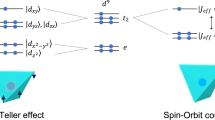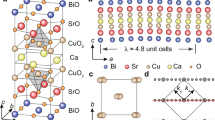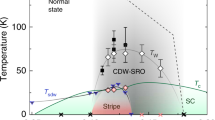Abstract
Ruddlesden-Popper and reduced Ruddlesden-Popper nickelates are intriguing candidates for mimicking the properties of high-temperature superconducting cuprates. The degree of similarity between these nickelates and cuprates has been the subject of considerable debate. Resonant inelastic x-ray scattering (RIXS) has played an important role in exploring their electronic and magnetic excitations, but these efforts have been stymied by inconsistencies between different samples and the lack of publicly available data for detailed comparison. To address this issue, we present open RIXS data on La4Ni3O10 and La4Ni3O8.
Similar content being viewed by others
Background & Summary
Generating analogs of the copper-based high-temperature superconductors based on different transition metal ions has been a major goal of materials research since the 1980s, as this opens routes to improving our understanding of unconventional superconductivity and realizing materials with improved properties1,2,3. Since nickel lies immediately to the left of copper in the periodic table, it represents an obvious target element for realizing new superconductors. However, despite extensive work, no superconductivity has been found in nominally Ni 3d8 or 3d7 compounds4,5,6. One route to realizing the desired 3d9 state found in copper-based superconductors in a nickel oxide has been achieved by preparing members of the Ruddlesden-Popper phase materials with formula Rn + 1NinO3n + 1 (where R is a rare earth element) and reducing them through removal of their apical oxygen atoms, forming Rn + 1NinO2n + 2 materials [see Fig. 1a,b]. Indeed, this approach has been validated by the discovery of superconductivity in infinite layer n = ∞ R1-xSrxNiO2, and subsequently n = 5 Nd6Ni5O12, generating intense scientific interest7,8,9,10.
Summary of study. (a,b) Crystal structure of (a) La4Ni3O10 and (b) La4Ni3O8. La, Ni, and O atoms are depicted by green, gray, and red spheres, respectively. (c) The experimental geometry showing the incident x-ray angle θi, the scattering angle 2Θ, and incident x-ray polarization π and σ. (d) An example RIXS spectrum, which encodes the electronic structure of these materials.
Resonant x-ray spectroscopy offers several advantages for probing low valence nickelates11. It can probe small sample volumes, which is useful since these materials are challenging to prepare as large single crystals. Indeed, many low valence nickelate samples are only available in thin film form. Another unique feature is the ability of RIXS to selectively study different atomic species through the resonant process and its access to magnetic and orbital excitations, which are optically forbidden12. Efforts to understand the detailed electronic properties of Ruddlesden-Popper and reduced Ruddlesden-Popper nickelates have consequently relied heavily on resonant x-ray spectroscopy11,13,14,15,16,17,18,19,20,21,22,23.
However, much of this debate has been complicated by two major difficulties. The first is inconsistent spectra from nominally equivalent or very similar samples, an issue raised specifically in refs. 18,24. The second is the lack of open data, which precludes detailed direct comparison between samples. Herein, we provide RIXS data from bulk crystals of La4Ni3O10 (n = 3) and La4Ni3O8 (n = 3, after reduction). In addition, little publicly accessible advice is currently available for comparing RIXS datasets, so we take this opportunity to outline considerations in comparing RIXS data taken under different experimental conditions.
Methods
The parent Ruddlesden-Popper La4Ni3O10 was synthesized using the high pressure optical floating zone method at Argonne National Laboratory. During growth, 0.1 l/min of oxygen gas was flowed through the reaction chamber at 20 bar pressure and the feed rods were advanced at 4 mm/h over the 30 hour growth time. To improve homogeneity, the feed and seed rods were counter-rotated at 30 r.p.m. throughout this process. A similar procedure was used in ref. 25. The c-axis surface used in the measurement was mirror polished in water using diamond lapping paper. La4Ni3O8 single crystals were prepared by cleaving small crystals from the parent La4Ni3O10 crystals and reducing them by heating in a flowing 4% H2/Ar gas mixture at 350°C for five days. This procedure was used successfully in several prior works14,16,20,22,25.
Ni L3,2 RIXS as well as O K and Ni L3,2 x-ray absorption spectroscopy (XAS) measurements were performed at the AERHA instrument of the SEXTANTS beamline at the SOLEIL synchrotron. The spectrometer operates by dispersing the x-ray photons as a function of their energy onto a two-dimensional detector via the detailed optical scheme described in ref. 26. A sketch of the experimental geometry is displayed in Fig. 1c. All measurements were performed with the a and c sample axes in the horizontal scattering plane. At the Ni L edges, data were taken at θi = 15° degrees (θi is the angle between the incoming x-ray and the sample surface), the linear dichroism is obtained by switching the incident x-ray polarization between π and σ. For the O K edge, a fixed π x-ray polarization was used, the dichroism is obtained by measuring at θi = 15° and 90°. RIXS was measured at 2Θ = 95°, with an overall full-width at half-maximum (FWHM) energy resolution of 262 ± 9 meV, chosen in order to balance throughput and resolution. As is standard in modern RIXS experiments, the two-dimensional data are binned in the isoenergetic direction to form spectra and the pixel to energy loss conversion is performed by measuring the elastic line of the spectrometer while changing the beamline energy. The data describing this calibration are provided in the Technical Validation section.
Data Records
This Data Descriptor is based on data deposited in the Zenodo general-purpose open repository27. RIXS data are provided as text files with filename of the form La4Ni3O10_pi_850.0eV.dat, which specify the material, incident x-ray polarization, and incident energy. This information as well as the sample temperature are provided in the file header. XAS data are also provided as text files with a similar nomenclature, but which includes the absorption edge measured, for instance La4Ni3O8_sigma_OKedgeXAS.dat. These data are also plotted in Figs. 2–4. The XAS data displayed in Fig. 5 were taken in total fluorescence yield (TFY), but files also contain data taken in total electron yield (TEY) concomitantly. Finally, the data shown in Fig. 6a,b are stored in files elastic_850eV.dat and pixel_energy_dispersion.dat, respectively. The repository illustrates the data content using plotting scripts based on standard python stack of numpy, matplotlib, scipy, and pandas28,29,30. The jupyter-repo2docker is used to define the computational environment and making the code executable on services such as mybinder.org.
RIXS instrument parameters. (a) Elastic line measurement; a gaussian fit yields FWHM = 262 ± 9 meV. (b) Dispersion of the elastic line through the CCD detector, the calibration follows a second order polynomial (y = a + bx + cx2) with a = 912.7 eV, b = −7.24 × 10−2 eV/pixel, and c = 1.13 × 10−5 eV/pixel2.
Technical Validation
Figure 5 displays the Ni L2 and O K edge XAS and x-ray linear dichroism (XLD) of La4Ni3O10 and La4Ni3O8. The larger XAS white line area seen in La4Ni3O10 and the larger XLD in La4Ni3O8 are consistent with previous results14. A similarly large XLD in La4Ni3O8 is observed at the O K-edge [Fig. 5d]. These results confirm the quality of the samples used here. The energy resolution of the RIXS measurement was determined by fitting a Gaussian peak to a spectrum collected at an energy away from the resonance [Fig. 6a]. The data collected by the CCD area detector was converted to energy space using the calibration shown in Fig. 6b. Since the La M4-and Ni L3-edges overlap in energy, we also provide data at the Ni L2-edge in Fig. 4.
Usage Notes
Several technical issues make it quite difficult to measure RIXS in absolute units. We therefore present data in arbitrary units. We suggest comparing the preset spectra to other works after dividing both spectra by the integrated spectral intensity in the 0.5–15 eV energy range. It is better to exclude the elastic line from such comparisons, as the quasielastic intensity is particularly sensitive to extrinsic issues such as sample surface flatness.
To compare the data presented here with other data, care should be taken to account for possible differences in energy resolution between the different datasets. We suggest comparing data by convolving the higher-resolution spectrum with a lineshape that gives both spectra the same effective resolution.
Code availability
The data reported here were generated via synchrotron experiments and did not require any processing of datasets beyond trivial binning of the two-dimensional data into one-dimensional spectra and calibration of the energy loss.
References
Anisimov, V., Bukhvalov, D. & Rice, T. Electronic structure of possible nickelate analogs to the cuprates. Physical Review B 59, 7901 (1999).
Norman, M. R. Materials design for new superconductors. Reports on Progress in Physics 79, 074502 (2016).
Adler, R., Kang, C.-J., Yee, C.-H. & Kotliar, G. Correlated materials design: prospects and challenges. Reports on Progress in Physics 82, 012504 (2019).
Chaloupka, J. & Khaliullin, G. Orbital order and possible superconductivity in LaNiO3/LaMO3 superlattices. Phys. Rev. Lett. 100, 016404 (2008).
Hansmann, P. et al. Turning a nickelate fermi surface into a cupratelike one through heterostructuring. Phys. Rev. Lett. 103, 016401 (2009).
Disa, A. S. et al. Orbital engineering in symmetry-breaking polar heterostructures. Phys. Rev. Lett. 114, 026801 (2015).
Li, D. et al. Superconductivity in an infinite-layer nickelate. Nature 572, 624–627 (2019).
Osada, M. et al. A superconducting praseodymium nickelate with infinite layer structure. Nano Letters 20, 5735–5740 (2020).
Pan, G. A. et al. Superconductivity in a quintuple-layer square-planar nickelate. Nature Materials 21, 160–164 (2022).
Zeng, S. et al. Superconductivity in infinite-layer nickelate La1-xCaxNiO2 thin films. Science Advances 8, eabl9927 (2022).
Hepting, M., Dean, M. P. & Lee, W.-S. Soft x-ray spectroscopy of low-valence nickelates. Frontiers in Physics 9, 777 (2021).
Dean, M. Insights into the high temperature superconducting cuprates from resonant inelastic x-ray scattering. J. Magn. Magn. Mater. 376, 3–13 (2015).
Fabbris, G. et al. Doping dependence of collective spin and orbital excitations in the spin-1 quantum antiferromagnet La2-xSrxNiO4 observed by x rays. Physical Review Lett. 118, 156402 (2017).
Zhang, J. et al. Large orbital polarization in a metallic square-planar nickelate. Nature Physics 13, 864–869 (2017).
Hepting, M. et al. Electronic structure of the parent compound of superconducting infinite-layer nickelates. Nature Materials 19, 381–385 (2020).
Lin, J. Q. et al. Strong superexchange in a d9-δ nickelate revealed by resonant inelastic x-ray scattering. Physical Review Letters 126, 087001 (2021).
Lu, H. et al. Magnetic excitations in infinite-layer nickelates. Science 373, 213 (2021).
Higashi, K., Winder, M., Kuneš, J. & Hariki, A. Core-level x-ray spectroscopy of infinite-layer nickelate: LDA + DMFT study. Physical Review X 11, 041009 (2021).
Rossi, M. et al. Orbital and spin character of doped carriers in infinite-layer nickelates. Physical Review B 104, L220505 (2021).
Shen, Y. et al. Role of oxygen states in the low valence nickelate La4Ni3O8. Phys. Rev. X 12, 011055 (2022).
Norman, M. R. et al. Orbital polarization, charge transfer, and fluorescence in reduced valence nickelates. ArXiv:2302.09003 (2023).
Shen, Y. et al. Electronic character of charge order in square-planar low-valence nickelates. Phys. Rev. X 13, 011021 (2023).
Wang, Y., Fabbris, G., Dean, M. & Kotliar, G. EDRIXS: An open source toolkit for simulating spectra of resonant inelastic x-ray scattering. Computer Physics Communications 243, 151–165 (2019).
Krieger, G. et al. Charge and spin order dichotomy in NdNiO2 driven by the capping layer. Physical Review Letters 129, 027002 (2022).
Zhang, J. et al. Stacked charge stripes in the quasi-2D trilayer nickelate La4Ni3O8. Proceedings of the National Academy of Sciences 113, 8945–8950 (2016).
Chiuzbăian, S. G. et al. Design and performance of AERHA, a high acceptance high resolution soft x-ray spectrometer. Rev. Sci. Instrum. 85, 043108 (2014).
Gilberto Fabbris, M. mpmdean/Fabbris2023resonant: v1.0.0 Zenodo https://doi.org/10.5281/zenodo.7582152 (2023).
Harris, C. R. et al. Array programming with NumPy. Nature 585, 357–362 (2020).
Hunter, J. D. Matplotlib: A 2d graphics environment. Computing in Science & Engineering 9, 90–95 (2007).
McKinney, W. et al. Data structures for statistical computing in python. In Proceedings of the 9th Python in Science Conference, vol. 445, 51–56 (Austin, TX, 2010).
Acknowledgements
Work at Brookhaven and the University of Tennessee (RIXS measurements and the interpretation) was supported by the U.S. Department of Energy, Office of Science, Office of Basic Energy Sciences, under Award Number DE-SC0022311. Work at Argonne was supported by the U.S. DOE, Office of Science, Basic Energy Sciences, Materials Science and Engineering Division (nickelate sample synthesis and RIXS theory). We acknowledge SOLEIL for provision of synchrotron radiation facilities. This research used resources of the Advanced Photon Source, a U.S. Department of Energy (DOE) Office of Science user facility at Argonne National Laboratory and is based on research supported by the U.S. DOE Office of Science-Basic Energy Sciences, under Contract No. DE-AC02-06CH11357. This research used resources at the SIX beamline of the National Synchrotron Light Source II, a U.S. DOE Office of Science User Facility operated for the DOE Office of Science by Brookhaven National Laboratory under Contract No. DE-SC0012704. G.S.C. acknowledges the support of the Agence Nationale de la Recherche (ANR), under Grant No. ANR-05-NANO-074 (HR-RXRS).
Author information
Authors and Affiliations
Contributions
The project was conceived and supervised by G.F. & M.P.M.D. G.F., D.M., Y.S., V.B., J. F., G.S.C., A.N., N. J. & M.P.M.D. performed the x-ray measurements. J.Z. & J.F.M. synthesized the samples. G.F., D.M., Y.S., S.J., M.R.N., & M.P.M.D. performed the technical validation of the data. All authors reviewed the manuscript.
Corresponding authors
Ethics declarations
Competing interests
The authors declare no competing interests.
Additional information
Publisher’s note Springer Nature remains neutral with regard to jurisdictional claims in published maps and institutional affiliations.
Rights and permissions
Open Access This article is licensed under a Creative Commons Attribution 4.0 International License, which permits use, sharing, adaptation, distribution and reproduction in any medium or format, as long as you give appropriate credit to the original author(s) and the source, provide a link to the Creative Commons license, and indicate if changes were made. The images or other third party material in this article are included in the article’s Creative Commons license, unless indicated otherwise in a credit line to the material. If material is not included in the article’s Creative Commons license and your intended use is not permitted by statutory regulation or exceeds the permitted use, you will need to obtain permission directly from the copyright holder. To view a copy of this license, visit http://creativecommons.org/licenses/by/4.0/.
About this article
Cite this article
Fabbris, G., Meyers, D., Shen, Y. et al. Resonant inelastic x-ray scattering data for Ruddlesden-Popper and reduced Ruddlesden-Popper nickelates. Sci Data 10, 174 (2023). https://doi.org/10.1038/s41597-023-02079-1
Received:
Accepted:
Published:
DOI: https://doi.org/10.1038/s41597-023-02079-1









